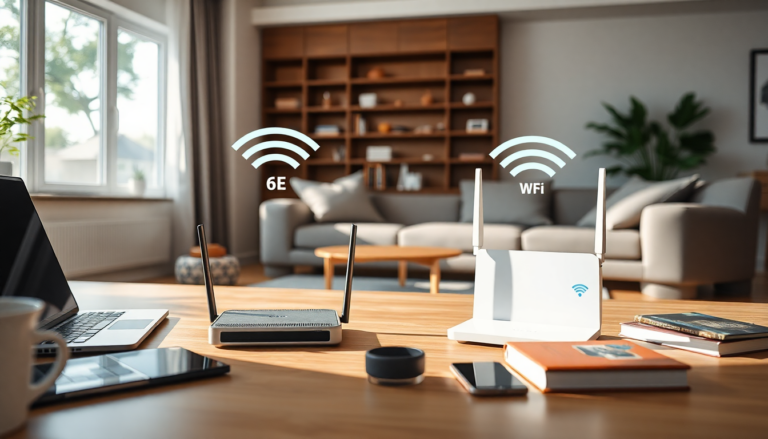Argomenti trattati
Understanding the evolution of Wi-Fi technology
The landscape of wireless networking has undergone significant changes in recent years, with new standards continually emerging. Currently, Wi-Fi 6, Wi-Fi 6E, and the latest Wi-Fi 7 are the primary options available to consumers. Wi-Fi 6 made its debut in 2019, followed by Wi-Fi 6E in 2021, which expanded capabilities by introducing the 6 GHz band. Now, with Wi-Fi 7 starting to hit shelves in late 2023, many are left wondering whether it’s worth upgrading from the already capable Wi-Fi 6E.
What Wi-Fi 7 brings to the table
Wi-Fi 7 introduces several enhancements that promise to improve overall performance significantly. Both Wi-Fi 6E and Wi-Fi 7 operate on the 2.4 GHz, 5 GHz, and 6 GHz frequency bands, but Wi-Fi 7 expands the channel bandwidth from 160 MHz to a staggering 320 MHz. This change alone doubles the maximum number of spatial streams from eight to sixteen, allowing for vastly improved data throughput.
To put this into perspective, Wi-Fi 7 can achieve a theoretical maximum data rate of 46 Gbps, compared to Wi-Fi 6E’s 9.6 Gbps. These figures indicate a substantial leap in performance, especially for users with high bandwidth demands, like gamers or those streaming high-definition content. The table below summarizes the critical specifications:
Wi-Fi Technology Comparison
| Feature | Wi-Fi 6E | Wi-Fi 7 |
|---|---|---|
| IEEE Standard | 802.11ax | 802.11be |
| Wireless Bands | 2.4 GHz, 5 GHz, 6 GHz | 2.4 GHz, 5 GHz, 6 GHz |
| Max Channel Bandwidth | 160 MHz | 320 MHz |
| Maximum Spatial Streams | 8 | 16 |
| Maximum Bandwidth per Stream | 1,200 Mbps | 2,400 Mbps |
| Theoretical Max Data Rate | 9.6 Gbps | 46 Gbps |
Multi-Link Operation: A game changer
One of the standout features of Wi-Fi 7 is Multi-Link Operation (MLO), which allows devices to connect across multiple frequency bands simultaneously. This capability enhances performance and provides improved reliability by enabling load balancing and reducing network latency. For example, a Wi-Fi 7 device might aggregate connections from the 2.4 GHz and 5 GHz bands, or even combine all three bands for a single client connection. This innovation is particularly beneficial in environments with multiple devices clamoring for bandwidth.
Evaluating the difference in performance
Real-world testing has revealed that Wi-Fi 7 routers can achieve impressive speeds compared to their Wi-Fi 6E counterparts. While Wi-Fi 6E routers typically max out at around 1,600 to 1,700 Mbps on the 6 GHz band, Wi-Fi 7 routers are capable of exceeding 3,000 Mbps in optimal conditions. The Asus ZenWiFi BQ16 Pro, for instance, reached speeds of 3,500 Mbps during testing, showcasing the potential of this new standard.
For users who rely on a stable and fast connection for activities like online gaming or 4K streaming, these advancements are significant. The improved performance of Wi-Fi 7 is not only about speed; it also enhances the overall user experience by minimizing lag and buffering.
Cost considerations: Is it worth the upgrade?
When considering an upgrade, cost is often a significant factor. Wi-Fi 6E routers are available at lower price points, making them an attractive option for budget-conscious consumers. For instance, the TP-Link AXE5400 and Asus RT-AXE7800 are competitively priced at $149.99 and $199.99, respectively. However, Wi-Fi 7 routers, such as the TP-Link Archer BE550, start at around $199.99, while mesh solutions can push prices even higher.
It’s essential to weigh the benefits of performance and future-proofing against the additional cost. While Wi-Fi 7 routers may command a premium, they offer advantages in speed, capacity, and overall performance that are hard to ignore, especially as more devices become connected.
Final thoughts on choosing between Wi-Fi 6E and Wi-Fi 7
In conclusion, while Wi-Fi 6E remains a capable option for many users, the advancements offered by Wi-Fi 7 present compelling reasons to consider an upgrade. The combination of higher speeds, improved reliability through MLO, and greater capacity makes Wi-Fi 7 a future-oriented choice. For those who can take advantage of these improvements, investing in a Wi-Fi 7 router could significantly enhance your wireless experience.
Ultimately, the decision should align with your specific needs and usage patterns. If you frequently engage in high-bandwidth activities or have a growing number of smart devices, the upgrade to Wi-Fi 7 is likely worth the investment.

